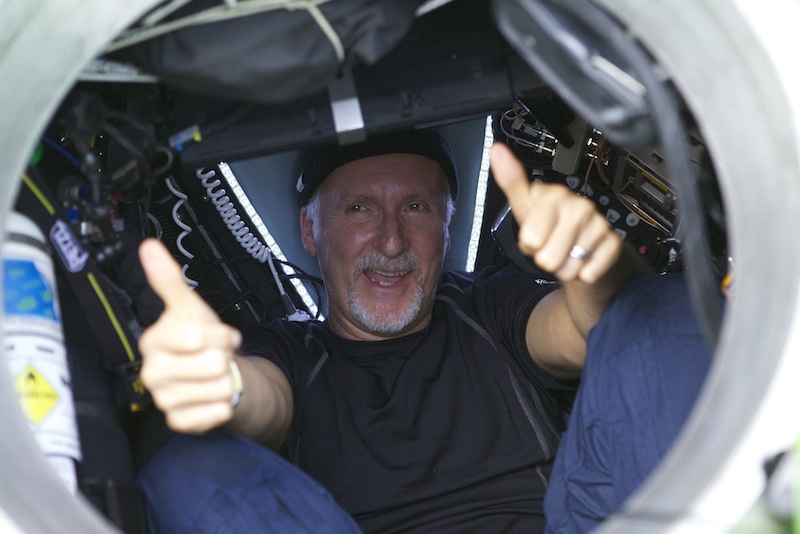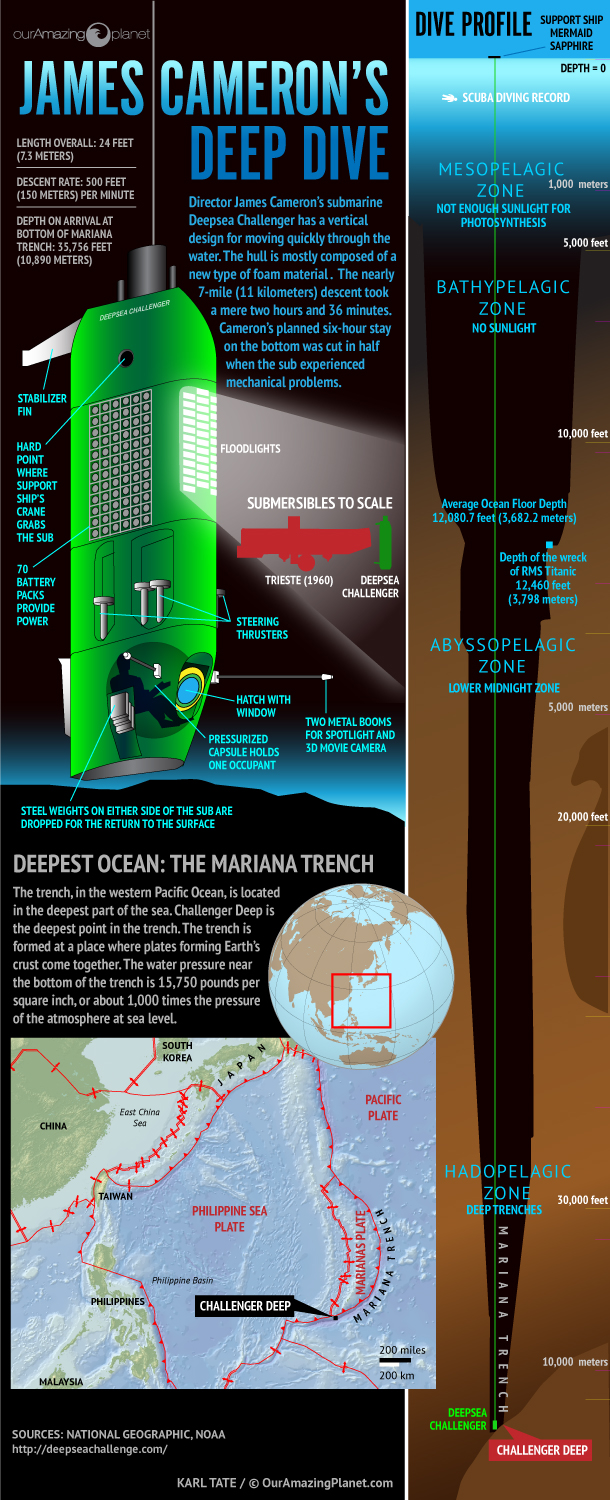James Cameron's Deepest Ocean Dive Splashes onto the Big Screen

NEW YORK — James Cameron doesn't remember what candy bar he was eating on his seven-hour round-trip journey to the deepest pit in the ocean.
"But if there had been any promotional tie-in money involved, I would have been showing it in front of the camera," Cameron said. "It's hard to fund a deep-ocean expedition, so I would not be above that."
With funding for scientific research facing widespread cuts in recent years, the famed filmmaker and ocean explorer thinks it's a "waste of breath" to go in front of congressional panels to make a case for the importance of deep-sea expeditions. He'd rather spend his time trying to stoke the curiosity of young people. [See Photos from James Cameron's Deep Dive]
That's why he was here Monday (Aug. 4) at the American Museum of Natural History to screen his 90-minute documentary "Deepsea Challenge 3D" (National Geographic) for an audience of mostly children and their minders, who had questions afterwards about submarine snacking and whether they can expect to see any marine-inspired aliens in "Avatar 2." (Yes, they can.)
Outside the museum, surrounded by a private security detail, sat Cameron's co-star: the lime-green sub named Deepsea Challenger, now in standby mode two years after the filmmaker's record-setting dive to the Mariana Trench, 7 miles (11 kilometers) below the surface of the Pacific Ocean.
Journey to the deep
Four years ago, German director Werner Herzog used 3D cameras to bring audiences face-to-face with the largely inaccessible, 32,000-year-old Chauvet paintings in his documentary "Cave of Forgotten Dreams." In the same tradition, Cameron brought 3D cameras with him on an underwater journey that few other humans will ever experience.
Get the world’s most fascinating discoveries delivered straight to your inbox.
But unlike Herzog's film, with its digressive musings on albino crocodiles and eerie choral soundtrack, Cameron's 3D documentary has the feel of a blockbuster — which perhaps isn't surprising, considering he's the man behind Hollywood mega-successes like "Titanic" and "Avatar."
There are reality-show-style clips of Cameron chastising his engineering team over lapsed deadlines. There are dramatized flashbacks of Cameron as a boy who used crayons to draw gauges on a cardboard-box-turned-imaginary sub. There are shots of his wife, Suzy Amis, with her face crumpled behind a wad of tissues after kissing her husband goodbye as he embarked on his big dive.
The quietest moment of the film is saved for the climax: On March 26, 2012, after nine test dives of increasing difficulty, Cameron reached the Mariana Trench's Challenger Deep, which, at about 36,000 feet (11,000 meters) below the surface, is the deepest point in the ocean. He was the only person in history to make the dive alone, and the first visitor to Challenger Deep since Navy Lt. Don Walsh and Jacques Piccard arrived there inside the Navy's bathyscaphe Trieste in 1960.
"We imagine the trench as kind of looking like the Grand Canyon with these really steep sides … that's not what it is," Cameron told the audience. The desolation at the frigid bottom of the trench looks more like a snowfield, with gradual slopes of sands and not a critter in sight, he said. (However, scientists would later discover 68 new species of bacteria in Cameron's sediment samples.)
The need to explore
In response to a girl in the audience who asked if there was more to see in the Mariana Trench, Cameron used a metaphor to emphasize how little of the ocean floor in these deep underwater canyons has been observed with human eyes.
"It was like I jumped out of an airplane at night over a wheat field in Nebraska, landed with a parachute, walked around with a flashlight for three hours and then went back up and said that I had explored America," Cameron said.
Speaking to reporters later, the filmmaker said he thinks kids are especially equipped to grasp the symbolic importance of exploring remote parts of the ocean that could hold clues about extreme life forms and the forces behind devastating earthquakes and tsunamis.
"Where our time is best spent is, I think, here, talking to young people who are curious and who are going to hopefully carry that desire to know how the natural world works forward into their lives," Cameron said. "Hopefully, it'll influence their voting [and] their prioritization of where money goes in the future. That's all I can hope for."
In fiscal year 2014, the National Oceanic and Atmospheric Administration's (NOAA) entire budget for ocean exploration was about $26 million. For comparison, Cameron spent a reported $10 million of his own money to build the Deepsea Challenger; NASA's exploration budget last year topped $4 billion.
A bleak situation
Cameron said promoting his movie hasn't made him more optimistic about the future of the funding situation, and he's tired of appearing before Senate hearings and subcommittees to ask for more spending on efforts like his.
During his appearance on Monday, Cameron sat in a director's chair alongside astrophysicist Neil deGrasse Tyson, who is head of the museum's Hayden Planetarium and the host of "Cosmos: A Spacetime Odyssey."
A "snarky" email from Tyson famously prompted Cameron to fix the constellations in "Titanic" for the 3D relaunch of the film two years ago. This time, Tyson did not raise any complaints about the science portrayed in "Deepsea Challenge 3D," at least not publicly. But he did agree that funding for ocean exploration is grim, and added: "If you have a Congress that wants to explore, then you don't need hearings telling them why we should explore. It's very simple."
In May, the remotely operated vehicle (ROV) Nereus imploded inside the Kermadec Trench, off the coast of New Zealand. Now, the only machine capable of diving to extreme depths inside the ocean's trenches is the Deepsea Challenger, which Cameron donated to the Woods Hole Oceanographic Institution in Massachusetts last year.
"That's kind of a ridiculous situation for the U.S. to be in, for human civilization to be in," Cameron said. "That we actually can't go to an area of our planet, to a surface of our planet that's the size of North America. We don't have the equipment to go there. I think it starkly demonstrates the need that we have for this funding."
"Deepsea Challenge 3D" opens in theaters Friday (Aug. 8).
Follow Megan Gannon on Twitter and Google+. Follow us @livescience, Facebook& Google+. Original article on Live Science.





